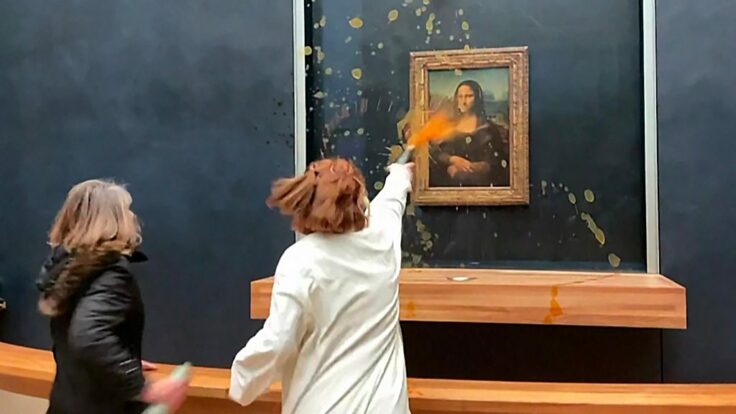Arguably one of the most effective ways to bring the subject of climate change back onto headlines is by splashing esteemed pieces of art in some form of a liquid. Although controversial and often perceived as an extreme method to raise awareness, splurging renowned artworks in paint, soup, or cake, has been embraced by countless environmental activists seeking to call for immediate action to mitigate global warming. And the attention-grabbing tactic has been put back to use over the past weekend.
On Jan. 28, two climate protesters were recorded splashing the iconic Mona Lisa with pumpkin soup at the Louvre Museum in Paris. Environmental group Riposte Alimentaire (which loosely translates to “Food Response” in English) quickly claimed responsibility for the incident through their official social media accounts, claiming that the act of defiance was part of a larger campaign that aims to shed light on food waste and unsustainable farming practices.
Fortunately, the 16th-century painting was left unharmed as it was encased in protective glass. A video capturing the event shows the two protesters actively tossing the broth and almost immediately confronting visitors of the Parisian landmark by asking them what is more important between “(…) art or the right to a healthy and sustainable diet?”
🦺 ACTION EN COURS – PARIS
Dimanche 28 janvier. 10h00
2 citoyennes engagées avec la nouvelle campagne Riposte Alimentaire ont aspergé de soupe le tableau “La Joconde” mondialement connu, exposé au Musée du Louvre. [1]#RiposteAlimentaire #A22Network #Joconde #Louvre pic.twitter.com/wfdUhf6K5G
— Riposte Alimentaire (@riposte_alim) January 28, 2024
In the past, similar events saw paintings from Van Gogh and Picasso be the subjects of the exact same treatment, however, given the urgency of the situation we are all in, one can only wonder how many more artworks need to be defaced before we collectively recognize and deal with the gravity of this given struggle.
Yes, leveraging shock value for any kind of attention isn’t ideal for getting a message across as people will tend to pay more attention to the means rather than the end, however, it seems as if at this point, these methods are the only way to slice through noise and draw just about enough attention to the issues at hand. As these events have become increasingly common, why does it feel so difficult for us to locate and tackle their common thread?
Let’s face it, any reasonable person wouldn’t willingly damage an age-old piece of history, spend hours in custody, and face a lengthy trial at court. Yet, if resorting to such extremes becomes necessary for someone to be heard, does it not signal a deep level of neglect for an issue that adamantly deserves more scrutiny? And it quite frankly feels like it is barely even enough as from the outside looking in, the first-concerned institutions appear to have gone above and beyond to find ways to preserve their artworks rather than redirect all of their efforts and resources towards addressing the root causes behind such practices.
As cultural artifacts are now bearing the harsh brunt of these symbolic protests, it’s worth wondering how many more times do these protesters need to resort to such extreme measures, and for media outlets to repeatedly report on them before we finally decide to do something about it rather than complacently bear witness to our own downfall.









